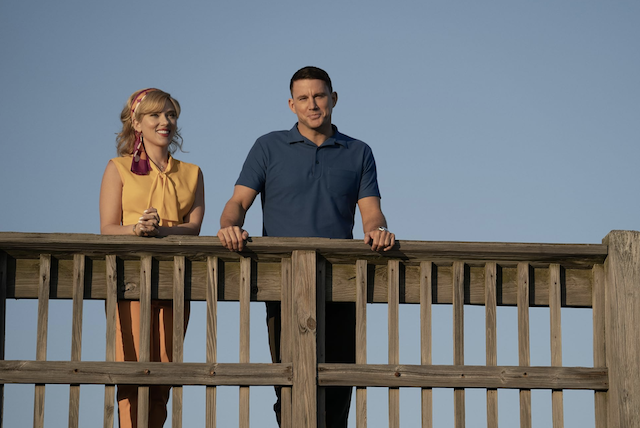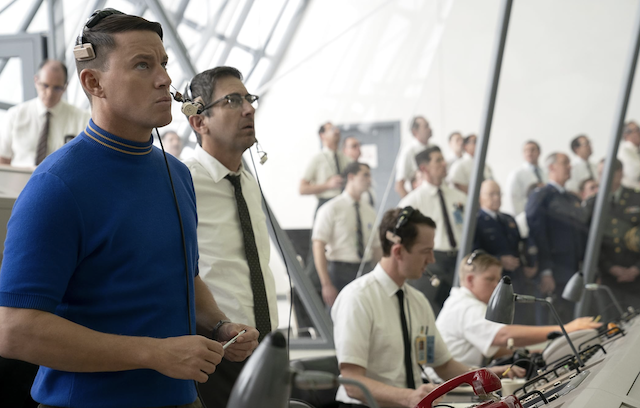
©Courtesy of Focus Features
Certain historical events leave such an significant impact on society’s trajectory that some people choose to believe they were faked to satisfy a political agenda. That immediately happened when Neil Armstrong and Buzz Aldrin became the first people to walk on the moon as part of NASA’s Apollo 11 mission 55 years ago, on July 20, 1969. The resulting conspiracy theory that the moon landing was faked, which is still believed by a portion of Americans, is one of the powerful driving forces in the new period romantic dramedy, Fly Me to the Moon.
The film was directed by Love, Simon helmer, Greg Berlanti. Rose Gilroy wrote the movie’s screenplay, which is based on a story by Bill Kirstein and Keenan Flynn. The dramedy features an ensemble cast that’s led by Scarlett Johansson, Channing Tatum, Jim Rash, Anna Garcia, Donald Elise Watkins, Noah Robbins, Colin Woodell, Christian Zuber, Nick Dillenburg, Ray Romano and Woody Harrelson.
Fly Me to the Moon follows Kelly Jones (Johansson), an advertising executive who has found success working in the male-dominated industry in the late 1960s. She’s given her latest obstacle of revitalizing the world’s interest in America’s space race through an extensive propaganda campaign by mysterious government agent Moe Berkus (Harrelson).
Kelly does so through extensive product placement deals. She also sets up fake television interviews with actors who portray members of the Apollo 11 team, including NASA’s launch director Cole Davis (Tatum). As the builder of the Apollo 11 spacecraft, he takes his job so seriously that he initially protests Kelly’s presence at the Kennedy Space Center.
Despite innocently flirting, the two also build an immediate tension with each other when they first meet. Cole is sincere in his emotions and actions, while Kelly resorts to being a compulsive liar in order to get what she wants. They have nothing in common except their shared goal of sending Armstrong (Nick Dillenburg), Aldrin (Colin Woodell) and Michael Collins (Christian Zuber) to the moon.

©Courtesy of Focus Features
Despite their differences, both Cole and Kelly have faith in the space crew’s ability to safely land on the moon. However, Moe isn’t willing to take any chances that the rest of the world may see the astronauts not successfully completing their mission. The secretive government operative demanded that Kelly film a fake moon landing without Cole’s knowledge.
Kelly initially embraces Moe’s plan, as he promises that if she follows his orders, he’ll expunge her past illegal acts. However, the more she gets to know Cole and his colleagues on the Apollo 11 launch team, the more she begins to feel guilty about her actions. She finally realizes that she has to change not only the world’s views on NASA, but also her own actions, in order to secure the happiness she has so long desired.
The film thrives on the optimism that Kelly and Cole fuse into the Apollo 11 launch mission, despite the political turmoil it’s set against. Gilroy’s script uses the Cold War, the Vietnam War and the growing distrust of newly-elected President Richard Nixon to highlight NASA’s determination to be the first to lead a manned mission to the moon, in order to boost American morale.
Fly Me to the Moon also surprisingly succeeds in championing Apollo 11’s accomplishments through Kelly and Cole’s growing connection. Johansson and Tatum emphasize their characters’ initial gender role reversals – Kelly is a career-driven professional who finds accomplishment in conquering each campaign, while Cole embraces the humanity and personal connections he makes in his job. But as they get to know each other while working together, they realize combining both ways of working can offer them the most success.
Kelly’s agreement to follow Moe’s orders gives some credence to the conspiracy theory that NASA faked the moon landing in 1969, despite ultimately undermining Armstrong and Aldrin’s accomplishments. However, introducing the idea halfway through the movie as a supporting plot point, instead of making it the main focus of the story, offers Kelly a way to redeem her past mistakes.

©Courtesy of Focus Features
Fly Me to the Moon‘s love and political plot points are brought to the screen with a colorful sleekness by Oscar-nominated director of photography, Dariusz Wolski. Known in part for shooting another space film, The Martian, he crafted a wistful and sharp evocation of 1960s visual aesthetics for his latest feature.
The varying perspectives of Kelly and Cole are highlighted by split screens that are reminiscent of the era. The split screen cinematography is amplified by Motown-scored montages that are composed by Daniel Pemberton.
Wolski’s cinematography also highlights the visual style of Mary Zophres’ costume design, particularly the vintage dresses and skirts that Johansson is regularly outfitted in. Shane Valentino’s production design, particularly during the scenes that were shot on location at NASA’s Kennedy Space Center on Merritt Island, Florida, also shine on screen.
Fly Me to the Moon succeeds in interweaving serious political and comedic romantic elements into its examination of NASA’s historic Apollo 11 mission 55 years ago. While they clash over their competing values and motives behind their work, Kelly and Cole bond over their optimism and banter, which champions their mutual mission. The protagonists’ charming love story, combined with its exploration into the historic moon landing and sleek visual aesthetics, make the dramedy a charming expedition.
Fly Me to the Moon is now playing exclusively in theaters, courtesy of Sony Pictures. The Apple Original Film is expected to begin streaming on Apple TV+ at a later date.
Grade: A-
If you liked this article, please share your comment below.
Check out more of Karen Benardello’s articles.
Here’s the trailer of the film. [Adsense]

